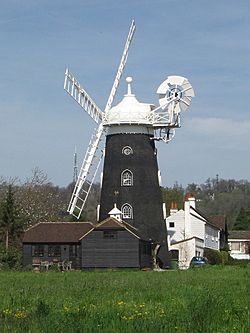Wray Common Mill, Reigate facts for kids
Quick facts for kids Wray Common Mill |
|
|---|---|

The converted mill in 2008
|
|
| Origin | |
| Mill name | Wray Common Mill |
| Grid reference | TQ 2689 5109 |
| Coordinates | 51°14′42″N 0°10′59″W / 51.245°N 0.183°W |
| Operator(s) | Private |
| Year built | 1824 |
| Information | |
| Purpose | Corn mill |
| Type | Tower mill |
| Storeys | Five storeys |
| No. of sails | Four sails |
| Type of sails | Double Patent sails |
| Windshaft | Cast iron |
| Winding | Fantail |
| Fantail blades | Six blades |
| Auxiliary power | Steam engine, later replaced by an oil engine |
Wray Common Mill is a historic tower mill located in Reigate, Surrey, England. It was once used to grind corn, but today it has been transformed into a unique home. This building is very important because it is a "Grade II* listed" site, meaning it's a special old building that needs to be protected.
Contents
History of the Mill
Wray Common Mill was built in 1824. For many years, it used the power of the wind to grind corn. However, in 1895, an accident damaged one of its sails. The mill also had extra power from a steam engine, which was later replaced by an oil engine. This helped the mill work even when there wasn't enough wind.
Around 1900, parts were removed from the sails. The sails then got old and worn out quickly. In 1928, new sails were put on by a special builder named Thomas Hunt. At this time, most of the old grinding machines inside the mill were taken out, except for the main shaft that turned the sails and a large wheel called the Brake Wheel.
Living in the Mill
Wray Common Mill was changed into a house in 1967. In the late 1990s, the mill started to look a bit run down. But in 2004, a new owner began to fix it up.
Today, the mill house has four bedrooms, a kitchen and dining area, a living room, and bathrooms. It even has a wine cellar and a garden with a terrace. In 2007, it was listed for sale as a very special property.
Restoring the Mill
A big part of the mill, called the cap (the top part that holds the sails), was taken off on August 26, 2004. A new cap was built, and the whole building was cleaned up. Old tar was removed from the outside, and a fresh coat was put on the tower. The new cap was lifted onto the mill by a crane in 2005.
In 2006, permission was asked to replace the sails. The new sails were put on in December 2007. Experts helped make sure the mill looked like it did when it was working. For the new sails, a modern way of making strong wooden beams was used. Because of all this hard work, the mill was removed from a list of "Buildings at Risk" in 2006, meaning it was no longer in danger of falling apart.
What the Mill Looks Like
Wray Common Mill is a tall, five-story building made of brick. It has a special curved roof called an "ogee cap" with a walkway around it. It has four "double Patent sails," which are a type of windmill sail, attached to a strong cast iron shaft. The cap can turn to face the wind thanks to a "fantail," which is like a small propeller at the back.
Inside, only the large cast iron Brake Wheel remains of the original machinery. We know that the millstones, which ground the corn, were driven from above. The base of the tower is about 20 feet (6 meters) wide, and it gets narrower at the top, where it's about 12 feet (3.6 meters) wide. The tower stands about 45 feet (13.7 meters) tall up to the cap.
People Who Ran the Mill
Here are some of the people who worked as millers at Wray Common Mill:
- Joseph Coulstock (1824–1832)
- Edward LArmer (around 1850)
- Robert Budgen (1855–1857)
- Joseph Henry Cooke (1874)
- Mrs M Cooke (1895)

